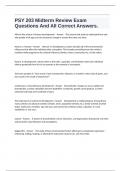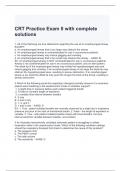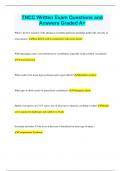PSY 203 Midterm Review Exam
Questions And All Correct Answers.
What is the science of human development? - Answer The science that seeks to understand how and
why people of all ages and circumstances change or remain the same over time.
Nature vs. Nurture - Answer Nurture: In development, nurture includes all of the environmental
influences that affect the individual after conception. This includes everything from the mother's
nutrition while pregnant to the cultural influences (family, school, community, etc.) in the nation.
Nature: In development, nature refers to the traits, capacities, and limitations that each individual
inherits genetically from his or her parents at the moment of conception.
The basic question is, "How much of any characteristic, behavior, or emotion is the result of genes, and
how much is the result of experience?"
Continuous vs. Discontinuous development - Answer Discontinuity: change can occur rapidly and
dramatically, as when caterpillars become butterflies. Continuity: growth can be gradual, as when
redwoods add rings over hundreds of years.
The importance of context to development - Answer Development is multicontextual. Among those
many contexts are physical contexts (climate, noise, population density, etc.), family contexts (marital
status, family size, members' age and sex), and community contexts (urban, suburban, or rural;
multiethnic or not; etc.).
Culture - Answer A system of shared beliefs, norms, behaviors, and expectations that persist over time
and prescribe social behavior and assumptions.
Epigenetics - Answer The study of how environmental factors affect genes and genetic expression—
enhancing, halting, shaping, or altering the expression of genes (ex. Lick Your Rats).
,Differential susceptibility - Answer Also called differential sensitivity - the idea that people vary in how
sensitive they are to particular experiences. Often such differences are genetic, which makes some
people affected "for better or for worse" by life events.
Critical vs. Sensitive periods - Answer Critical: A crucial time when a particular type of developmental
growth (in body or behavior) must happen for normal development to occur, or when harm (such as a
toxic substance or destructive event) can occur.
Sensitive: A time when a certain type of development is most likely, although it may still happen later
with more difficulty. For example, early childhood is considered a sensitive period for language learning.
Cohort - Answer People born within the same historical period who therefore move through life
together, experiencing the same events, new technologies, and cultural shifts at the same ages. For
example, the effect of the Internet varies depending on what cohort a person belongs to.
Cross-sectional vs. Longitudinal vs. Cross-sequential studies - Answer Cross-sectional: A research design
that compares groups of people who differ in age but are similar in other important characteristics.
Longitudinal: A research design in which the same individuals are followed over time, as their
development is repeatedly assessed.
Cross-sequential: A hybrid research design in which researchers first study several groups of people of
different ages (a cross-sectional approach) and then follow those groups over the years (a longitudinal
approach). (Also called cohort-sequential research or time-sequential research.)
Domains of development - Answer 1. Biosocial or biological: includes all the growth and change that
occur in a person's body and the genetic, nutritional, and health factors that affect that growth and
change. Motor skills - everything from grasping a rattle to driving a car - are also a part of the biological
domain.
2. Cognitive: includes all the mental processes that a person uses to obtain knowledge or to think about
the environment. Cognition encompasses perception, imagination, judgement, memory, and language -
the processes people use to think, decide, and learn. Education - not only the formal curriculum in
schools but also informal learning - is part of this domain as well.
,3. Psychosocial: includes development of emotions, temperament, and social skills. Family, friends, the
community, the culture, and the larger society are particularly central to the psychosocial domain. For
example, cultural differences in sex roles or in family structures are part of this domain.
Plasticity - Answer The idea that abilities, personality, and other human characteristics can change over
time. Plasticity is particularly evident during childhood, but even older adults are not always "set in their
ways."
Dynamic-systems approach - Answer A view of human development as an ongoing, ever-changing
interaction between the physical, cognitive, and psychosocial influences. The crucial understanding is
that development is never static but is always affected by, and affects, many systems of development.
Principles of research ethics - Answer The most important caution for all scientists, especially for those
studying humans, is to uphold ethical standards. Each academic discipline and professional society
involved in the study of human development has a code of ethics (a set of moral principles).
IRB - Answer Institutional Review Board: a group that permits only research that follows certain
guidelines.
Experiments vs. Correlational studies - Answer Experiment: A research method in which the researcher
tries to determine the cause-and-effect relationship between two variables by manipulating one (called
the independent variable) and then observing and recording the ensuing changes in the other (called the
dependent variable).
Correlation: A number between +1.0 and −1.0 that indicates the degree of relationship between two
variables, expressed in terms of the likelihood that one variable will (or will not) occur when the other
variable does (or does not). A correlation is positive if both variables tend to increase together or
decrease together, negative if one variable tends to increase while the other decreases, and zero if no
connection is evident. A correlation indicates only that two variables are somehow related, not that one
variable causes the other to occur.
Correlation coefficient and what it tells us (e.g., r = -.72) - Answer A number between +1.0 and −1.0
that indicates the degree of relationship between 2 variables. A correlation is positive if both variables
tend to increase together or decrease together, negative if one variable tends to increase while the other
decreases, and zero if no connection is evident.
, Behavioral developmental theory - Answer Studies observable behavior, objectively and scientifically.
Behaviorists believe there are natural laws of human behavior. Those laws allow simple actions to
become complex competencies, as various forces in the environment affect each action. Behaviorists
believe that development occurs not in stages but bit by bit.
3 types:
1. Classical Conditioning (Pavlov) - The learning process in which a meaningful stimulus (such as the smell
of food to a hungry animal) is connected with a neutral stimulus (such as the sound of a tone) that had
no special meaning before conditioning. (Also called respondent conditioning.)
2. Operant Conditioning (Skinner) -The learning process by which a particular action is followed by
something desired (which makes the person or animal more likely to repeat the action) or by something
unwanted (which makes the action less likely to be repeated). (Also called instrumental conditioning.)
3. Social Learning (Bandura): An extension of behaviorism that emphasizes the influence that other
people have over a person's behavior. Even without specific reinforcement, every individual learns many
things through observation and imitation of other people. (Also called observational learning.)
**modeling
Cognitive developmental theory - Answer A grand theory of human development that focuses on
changes in how people think over time. According to this theory, our thoughts shape our attitudes,
beliefs, and behaviors. - How children think changes with time and experience, and their thought
processes affect their behavior. According to cognitive theory, to understand humans of any age, one
must understand thinking.Piaget maintained that cognitive development occurs in 4 age-related periods,
or stages.
Psychodynamic developmental theory (Freud) - Answer A psychoanalytic theory where development
occurs in 5 stages, each characterized by sexual interest and pleasure arising from a particular part of the
body. In infancy, the erotic body part is the mouth (the oral stage); in early childhood, it is the anus (the
anal stage); in the preschool years, it is the penis (the phallic stage), a source of pride and fear among
boys and a reason for sadness and envy among girls. Then, after a quiet period (latency), the genital
stage arrives at puberty, lasting throughout adulthood.
Psychosocial developmental theory (Erikson) - Answer A psychoanalytic theory where development
occurs in 8 stages, each characterized by a particular challenge, or developmental crisis. Erikson named 2
polarities at each crisis, but he recognized a wide range of outcomes between those opposites. Typically,
development at each stage leads to neither extreme but to something in between. Erikson, like Freud,
believed that problems of adult life echo unresolved childhood conflicts.
Sociocultural developmental theory (Vygotsky) - Answer A newer theory which holds that development
results from the dynamic interaction of each person with the surrounding social and cultural forces.







